
We can all agree that giant monster fights are some of the best cinematic moments to grace the big screen. Whether it’s mechs fighting creatures from the ocean’s depth a la PACIFIC RIM, or watching the King Of The Monsters himself wiping out creatures from land, sea, and space, there is something so joyous about kaiju films. They are entertaining, gorgeous, and silly — a bowl of delicious comfort food that will make you smile no matter what. In a time like this one, monster movies are needed more than ever, to both entertain and remind us that there is a sliver of hope out there (wouldn’t it be cool if Mothra could end the pandemic?).
We’re bringing back Daily Grindhouse’s Big Question in honor of our kings Godzilla and Kong, who are facing off in the release of GODZILLA VS KONG (2021). We asked our contributors and community about their favorite kaiju (outside of Godzilla and King Kong), and boy, did they deliver. You’ll find the usual favorites, but you’ll also see a few unique choices that stretch our idea of the giant monster (we’re looking at you, Audrey II).
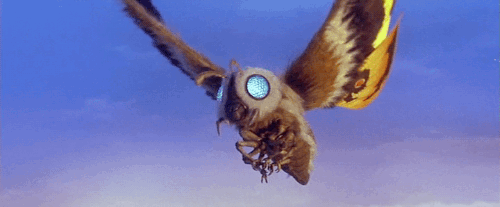
Mary Beth McAndrews (@mbmcandrews): Mothra, MOTHRA (1961)
What can I say about Mothra, my beautiful winged queen, flanked by singing twins, and flying around the world to help save humans from the wrath of Godzilla or whatever other creature threatens the safety of Earth? She is an ethereal being, and despite her often fleeting life, she is always resurrected through a cycle of rebirth, never abandoning her post as humanity’s protector.
Even as a giant moth, she is delicate and empathetic, which is seen in GHIDORAH THE THREE HEADED MONSTER as she begs Godzilla and Rodan to help destroy King Ghidorah and save the planet. She essentially plays mother to the two other kaiju who are throwing small temper tantrums and refuse to help. So, she puts herself in danger and leaves them behind. For better or worse, she is the only kaiju primarily seen being on the human’s side.
Mothra adds a complexity to a genre that is primarily about spectacle and big fights. Yet, from her introduction in the early 1961, she has been portrayed as more than a vicious monster, but a kaiju that understands humans and has an emotional connection with them. While she is worshipped on an island, meaning she does have supremacy over them, she is benevolent. She even has two small handmaidens that care and sing for her. I mean, how badass is that?
From my love of Mothra to Mothman, I obviously have a soft spot for moths. They’re so delicate yet so strong and while they may not be regarded as beautiful as butterflies, they exemplify an idea of resilience. Mothra encapsulates the fascinating aspects of kaiju, and I would like her to be my girlfriend.

Preston Fassel (@PrestonFassel): Mothra, MOTHRA (1961)
Godzilla was something of my first kaiju love — I caught the OG GOJIRA on late night TV in high school, if I recall correctly as an episode of TNT’s Monstervision. For someone who’d always associated the series with the rubber costumes and hokey dubbing I’d seen parodied in countless movies and television shows, it was something of a revelation — I had no idea that Godzilla could or should be scary, or that a kaiju movie could elicit a real sense of dread and human suffering. It launched me on a Summer’s long quest to hunt down and consume as much kaiju media as I could, and my obsession was abated not just by the local Reasors’ and Supermarket Warehouse Video stores but also, unexpectedly, KB Toys, who as it so happened were having a blowout sale on Godzilla merch. It truly was the Summer of Kaiju. And while I’ll always have a lasting respect for ‘Zilla, I’ve got to lean to my more sentimental tendencies and call Mothra my favorite. In so many of his iterations, Godzilla is a walking atom bomb come to sow pain and destruction. Kong needs some consent and harassment training. Ghidorah is just an asshole. Mothra? Mothra just wants to hang out on her lil paradise island and be left alone. She’s sweet tempered. She doesn’t want to fuck shit up or hurt anyone, and every time she’s wreaking havoc it’s just because she wants her little fairy friends back. Here you’ve got this giant, terrifying mothstrostity that can fly and do all kinds of gnarly stuff, but, does she use her powers for evil? No. She uses her powers to chill. For me, there’s always been a bit of difficult emotional navigation in rooting for the monster in movies — aesthetically they’re always the coolest thing onscreen, and, they’re the reason everyone’s come to see the movie in the first place (my apologies to Carol Clover), but at the same time, they’re also death merchants you wouldn’t want to meet in real life. Godzilla is only cool as long as it’s not you and your family running for your lives or getting baked to death in a building being vaporized with atomic energy. With Motha, there’s none of that attendant guilt. Mothra doesn’t want to fuck your shit up. Mothra just wants to hang. You can really see yourself being friends with her. And if you really got on well with her, maybe she’d even let you ride on her back. That’d be awesome. So, yeah — Mothra.
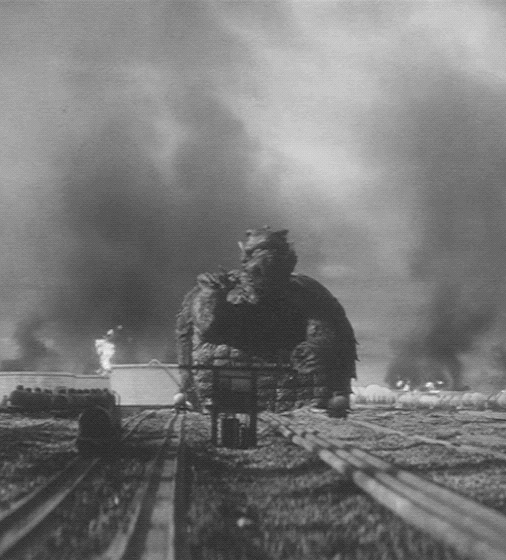
Brett Gallman (@brettgallman): Gamera, GAMERA, THE GIANT MONSTER (1965)
Full disclosure: I’ve always been a Godzilla guy. Sure, I’ve let other giant beasts — especially Toho’s colorful kaiju menagerie — capture my attention, but there’s a reason he’s called the Big G, you know? However, that changed recently with Arrow’s incredible complete GAMERA collection, which finally gave me an excuse to hang out with Daiei Film’s own kaiju mascot. If we’re being completely honest, we know that Gamera — a giant turtle who either terrorizes Japan or defends it from other creatures — doesn’t exist without Godzilla. Because he’s an unabashed rip-off, it’s easy to dismiss him as a jabroni, especially if you know his films were frequently lampooned on MST3K (a fate shared by Godzilla and other kaiju, to be fair).
But after spending the past twelve weeks really giving these films a shot, I must say that I am a convert: not only is there only one lackluster film in the bunch (1980’s GAMERA THE BRAVE, a low-rent clip show produced to capitalize on STAR WARS), but this series has such a distinct, infectious personality all its own. What started as an obvious GODZILLA imitator soon grew into a charming riff on a familiar theme. The GAMERA series essentially became a Saturday morning cartoon, complete with candy-colored production designs, an infectious theme song, and, of course, precocious kids getting into trouble (no submarine or a spaceship is safe — you’d think the adults would start putting a lock on these things). While the 1990s Heisei trilogy is rightfully regarded as one of the great kaiju series of all-time, the Showa era movies really captured my heart. They’re a true delight, all of them boasting creatures and settings that became more outlandish with each new entry: whether they’re evoking STAR TREK or FANTASTIC VOYAGE, these films are consistently just so damn fun.
Maybe Gamera hasn’t completely supplanted Godzilla in my heart, but he’s wedged himself in there sure enough. Some call him The Friend to All Children, others The Guardian of the Universe: for me, he’s “Little G,” the plucky upstart who whirled into my life with his spinning jets and an earworm theme song that hasn’t left my brain for three months. “You are strong, Gamera,” indeed.
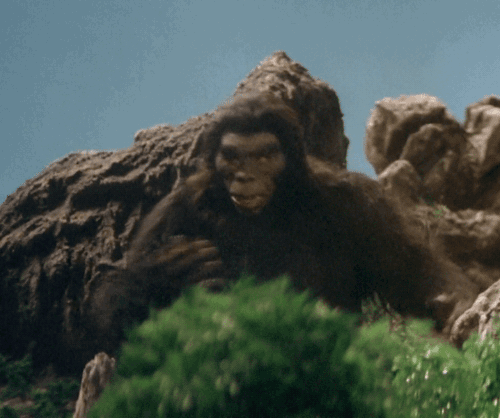
Matt Rotman (@bonkersasscin): Peking Man, THE MIGHTY PEKING MAN (1977)
Peking Man is the working man’s kaiju and a reminder to the more cynical of us that not every monster gets their fair shake of film, costume, or budget. Hailing from the Shaw Brothers’ KING KONG ’76 cash-in, THE MIGHTY PEKING MAN, the shabby origins of this particular giant ape are rooted in high camp and cheap exploitation filmmaking — making him somewhat of a target in cinephile circles for ironic viewing, especially following the film’s release on DVD from Quentin Tarantino’s Rolling Thunder Pictures label.
So, one: if I ever catch you in the act of ironic viewing, you’re dead to me. Two: because of the film’s stature (or lack therefore), much of the Peking Man’s tragedy is ignored. In the course of eighty-four minutes, he is friendzoned, King Konged, and burned alive. The facial work of the ape works just enough to convey a deep sadness and anguish, which taken with the brute violence inherent to Hong Kong cinema, delivers a real gut punch at the end, when the inevitable happens. The best kaiju films — and monster movies in general — give their creature a true pathos, and THE MIGHTY PEKING MAN succeeds, eh, mightily on this front.
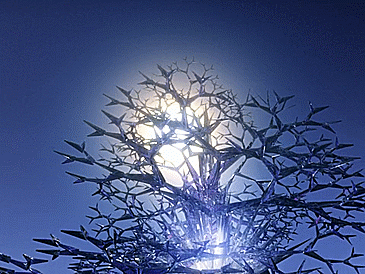
Jay Alary (@JuliusBarthelme): The Crystalline Entity, Star Trek: The Next Generation
Growing up watching Star Trek reruns, I learned that most so-called “monsters” were really misunderstood: the Salt Vampire of Planet M-113 was only killing the Enterprise crew in order to survive, being the last of its kind, while the Horta of Janus VI only killed a group of miners because they encroached on her lair of unhatched children. But then there’s the Crystalline Entity, a gargantuan cosmic creature that destroyed an entire Federation colony on Star Trek: The Next Generation. If TV viewers loathe the current iterations of Star Trek, they ought to remember that way back in 1987, the syndicated sequel to the ‘60s TV classic was much worse in its chaotic first season. It was a time when Captain Picard was always cranky, Riker didn’t have a beard, the Ferengi were introduced (badly) as the Federation’s new nemeses, and Wesley Crusher saved the ship on a semi-regular basis. However, there were a handful of episodes that weren’t awful, enough to convince silly children like yours truly from abandoning the series for 21 Jump Street, likely saving it from being merely a pop-culture footnote.

Series creator Gene Roddenberry wrote “Datalore,” an early episode which gave new insights into android officer Data’s origin and introduced a destructive space monster. The two would be inextricably linked, as the crew discovers Data’s disassembled twin, Lore on Omicron Theta, Data’s home world and the site of all those dead colonists (Data would encounter many other android members of his family in later episodes and one forgettable film). Lore is actually in cahoots with the Crystalline Entity and was responsible for the colonists’ death. How does the Crystalline Entity communicate with Lore? Where did it come from? What does it want? These questions aren’t answered, but it’s cool to see a space monster on Star Trek that isn’t a humanoid with a bumpy forehead. Its crystal snowflake appearance contradicts its deadly actions, proving that not all things bright and beautiful are harmless. It proves a threat to the Enterprise, but disappears at the end of the episode, never to return… until TNG’s fifth season!
In “The Silicon Avatar,” we see another Federation colony attacked by the Crystalline Entity, and this time Picard wants to try to communicate with it instead of destroying it, causing a rare moment of conflict with Riker. Picard recognizes its right to exist, even as it poses a threat to other beings. Unfortunately, just as Data establishes communication with it via a graviton pulse, the mother of one of Omicron Theta’s fallen colonists uses the pulse to destroy it. Farewell, Crystalline Entity — your mystery and deadly beauty have neither been forgotten nor matched by any of the subsequent Star Trek iterations.
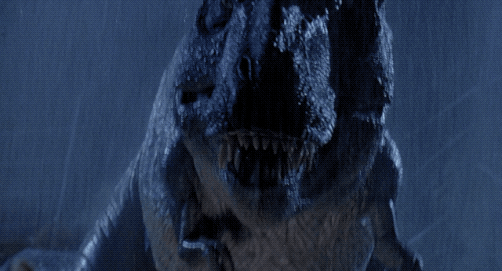
Bill Bria (@billbria): T-Rex, JURASSIC PARK (1993)
Unlike many giant monster fans, I wasn’t raised on the usual steady diet of classic kaiju films, not seeing the likes of GODZILLA, KING OF THE MONSTERS (1956) and KING KONG (1933) until I was older. The first proper giant monster I saw on screen was the Stay-Puft Marshmallow Man from 1984’s GHOSTBUSTERS, but that fellow is — to borrow a phrase from Peter Venkman — a real mother puss-bucket. My first favorite kaiju anti-hero came from a filmmaker heavily influenced by the classic giant monster films, Steven Spielberg, in his 1993 horror-adventure opus JURASSIC PARK. While the movie’s Velociraptors were the villains you loved to hate (and could hardly be called giant), the standout awe-(and terror-) inspiring character was unequivocally the T-Rex. Introduced in classic Spielbergian fashion in a scene that equally blends wonder and horror, the T-Rex popped off the screen thanks not just to ILM’s groundbreaking CGI work but also to Stan Winston’s team of animatronic wizards as well as the sound design team led by Gary Rydstrom, pushing the limits of the then-new Dolby Digital system in theaters. Thanks to Spielberg correctly predicting the audience’s embrace of the Rex, he conceived a new ending to the film where she saves our heroes from their Raptor fate, thus making the Rex a proper successor to the likes of Godzilla and King Kong. The subsequent sequels only developed the comparison further, seeing the Rex brought to San Diego in a sequence reminiscent of Kong’s NYC trip in THE LOST WORLD (1997), and feature her in a complete knock-down, drag-out kaiju fight with the Mechagodzilla-esque Indominus Rex in JURASSIC WORLD (2015). Over the years, my love of giant monsters has only grown with my discovering their various films, yet there will always be a special place in my heart for the roar and water-glass-rippling footstep of the T-Rex, an awe-inspiring foe and mighty heroine.

Jessica Scott (@WeWhoWalkHere): Audrey II, LITTLE SHOP OF HORRORS (1986)
Though a singing plant may not seem as fearsome a beast as a giant ape or a nuclear reptile, Audrey II from LITTLE SHOP OF HORRORS (1986) still fits the description of a gargantuan monster who destroys cities and bats away military squadrons like so many flies. In the infamously downbeat original ending to the musical horror-comedy, Audrey II murders its human namesake and swallows its caretaker Seymour Krelborn whole. Buoyed by a wave of consumerism and greed that allows clones of Audrey II to proliferate across the United States, the evil alien plants devour the cities of Cleveland and Peoria before running amok in New York City and then taking over the world.
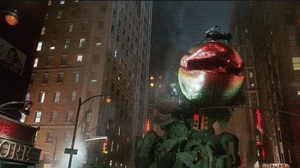
Do I prefer the original ending to the theatrical one, where Audrey and Seymour live happily ever after somewhere that’s green? No. I have far too much affection for Ellen Greene and Rick Moranis’s Skid Row lovers opting for their tragic demise in the Choose Your Own Adventure that is my Blu-ray copy of the film. But do I love the “Mean Green Mother from Outer Space” that is Audrey II? You bet I do. How can you love giant monsters and not have a soft spot for a carnivorous extraterrestrial plant with insatiable bloodlust and no apparent upper limit on its size? Throw in tremendous wit, attitude, and musical talent, and you’ve got a kaiju for the ages. Plus, Audrey II destroys cities with style, gobbling up subway trains with glee and cackling atop the Statue of Liberty like it owns the thing. Hell, by the end of LITTLE SHOP OF HORRORS, it does own Lady Liberty… and it owns humanity, too.

Jon Abrams (@jonzilla___): Garamon, Ultra Q (1966)
Garamon! Not to be confused with the controversial font Garamond, which of course battled Times New Roman in the lost film DESTROY ALL TYPEFACES (1969). Garamon is a beautifully dyspeptic-looking giant monster from the kaiju series Ultra Q, made by Tsuburaya Productions. (Eiji Tsuburaya, who we haven’t mentioned yet in this piece, is the effects maestro who had a major hand in making Godzilla the marquee idol we all admire.) I love Garamon because he’s got none of the charisma of Godzilla. He’s got none of the grace of Mothra. He’s got none of the fearsomeness of King Ghidorah. He’s sort of the antithesis of all those things. He’s his own opposite – apparently canonically a robot, who makes a metallic clang whenever he moves, but also weirdly organic, as evidenced by the sounds he makes, like a swarm of cicadas (which is almost certainly a recording of actual cicadas). If he is a robot, then without a doubt, Garamon is the most expressive-looking robot I could name. He’s the only robot that could conceivably be played by Wings Hauser.
I don’t want to anger Garamon by saying it, but he’s odd-looking, even by kaiju standards. Garamon looks sort of like a cross between a clump of coral and a chocolate mousse that’s gone stale. His movements are even stranger. Garamon short-hops and waddles, as if he’s fighting a sudden onset of diarrhea and worrying that any broader strides will unleash a torrent, and he’s pissed about it. When he attacks with his skeletal flippers, it’s an abbreviated motion, solely and sharply downward, like Dame Judi Dench exclaiming “Posh!” in some PBS drama. In fact, Garamon fights the way Dame Judi Dench might react upon hearing me broach the subject of diarrhea.


Garamon’s first appearance on film, in the thirteenth episode of Ultra Q, “Garadama,” is almost precisely framed like that “dramatic chipmunk” meme. He returned three episodes later, in “Garamon Strikes Back.” His big dramatic entrance there causes a cloud of dust that has to take an interminable moment to settle. Garamon has to sit and wait, sort of awkwardly, until it clears so he can reveal himself in all his glory. He looks extremely cranky about it. In short, he’s kind of a dipshit. I can relate. That’s why I love him.
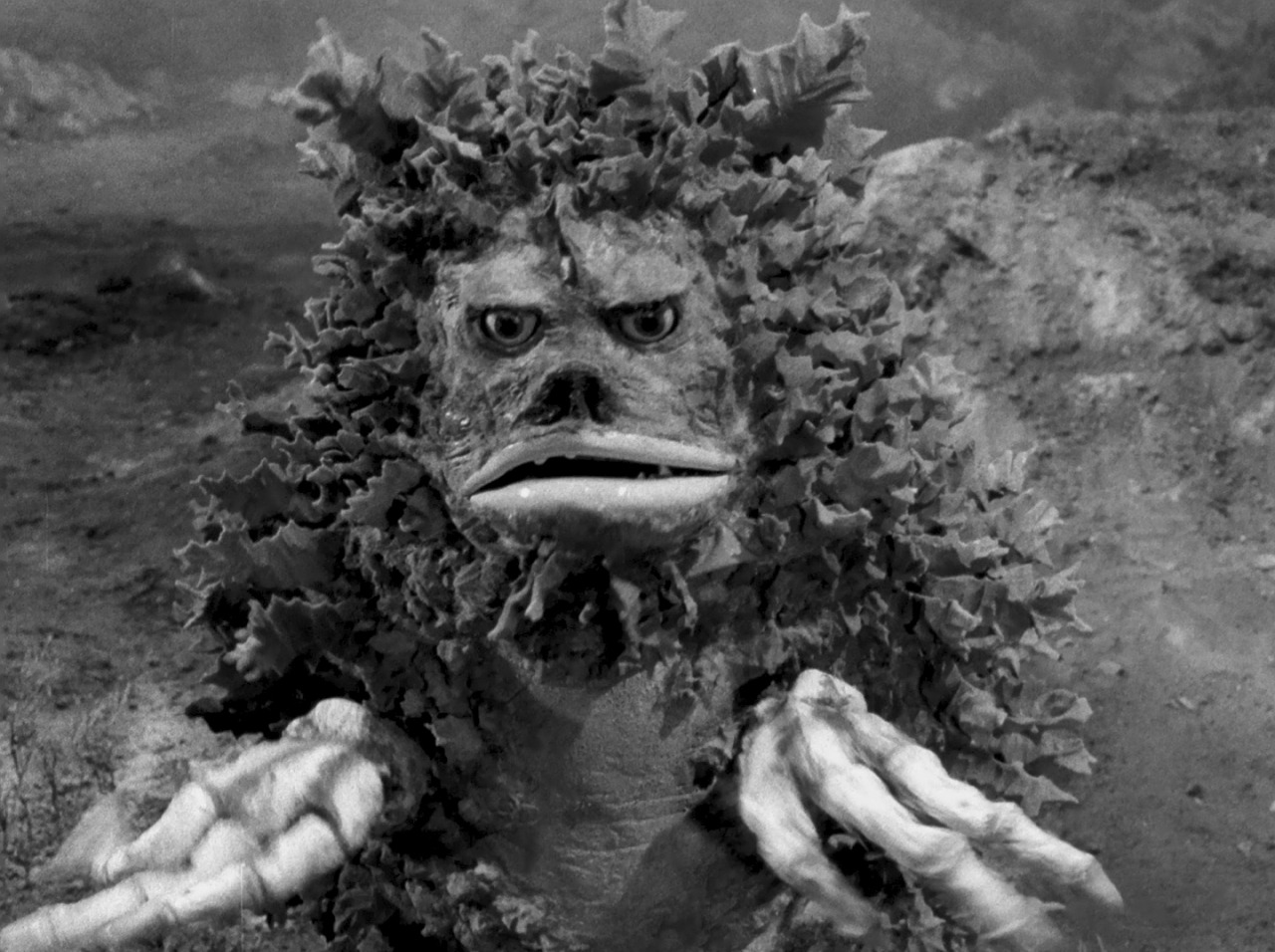
WHO IS YOUR FAVORITE KAIJU? GIVE US YOUR ANSWERS!
Tags: Aliens, Bugs, Dinosaurs, Flowers, gamera, Garamon, GODZILLA, kaiju, mothra, Sci-Fi, Turtles, Ultra Q

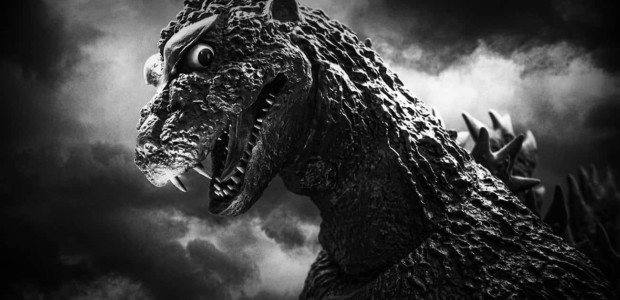

No Comments